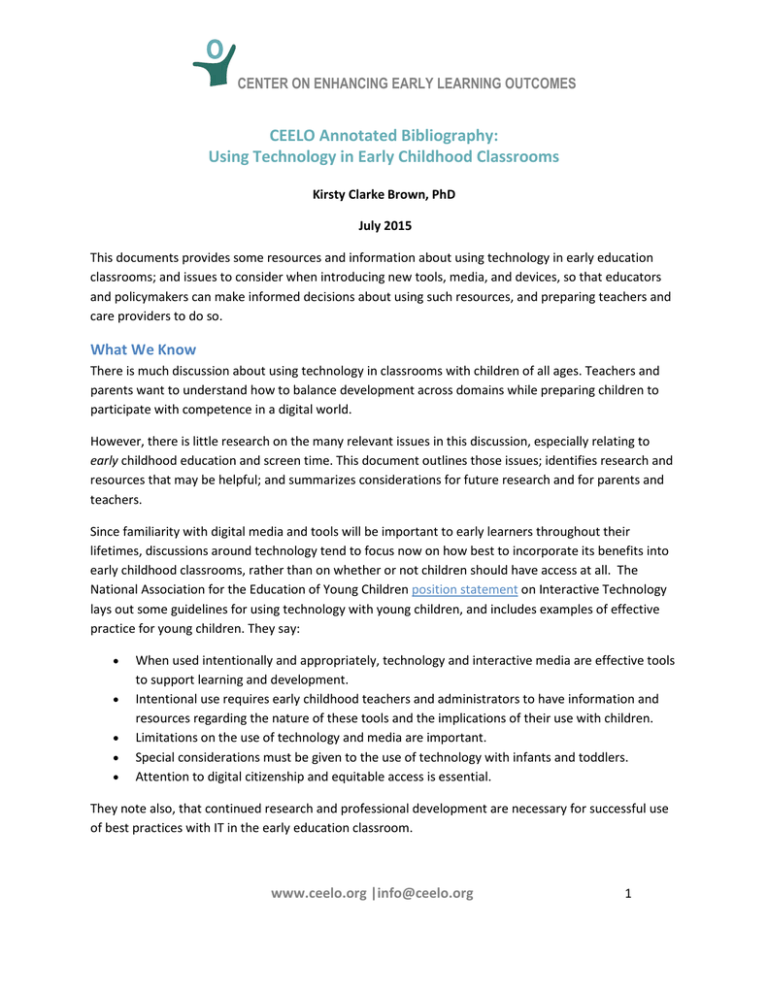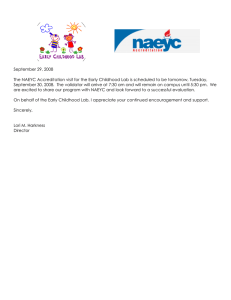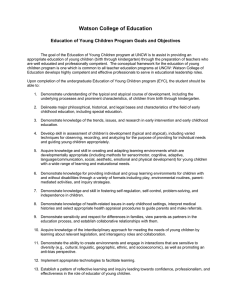CEELO Annotated Bibliography: Using Technology in Early Childhood Classrooms
advertisement

CENTER ON ENHANCING EARLY LEARNING OUTCOMES CEELO Annotated Bibliography: Using Technology in Early Childhood Classrooms Kirsty Clarke Brown, PhD July 2015 This documents provides some resources and information about using technology in early education classrooms; and issues to consider when introducing new tools, media, and devices, so that educators and policymakers can make informed decisions about using such resources, and preparing teachers and care providers to do so. What We Know There is much discussion about using technology in classrooms with children of all ages. Teachers and parents want to understand how to balance development across domains while preparing children to participate with competence in a digital world. However, there is little research on the many relevant issues in this discussion, especially relating to early childhood education and screen time. This document outlines those issues; identifies research and resources that may be helpful; and summarizes considerations for future research and for parents and teachers. Since familiarity with digital media and tools will be important to early learners throughout their lifetimes, discussions around technology tend to focus now on how best to incorporate its benefits into early childhood classrooms, rather than on whether or not children should have access at all. The National Association for the Education of Young Children position statement on Interactive Technology lays out some guidelines for using technology with young children, and includes examples of effective practice for young children. They say: • • • • • When used intentionally and appropriately, technology and interactive media are effective tools to support learning and development. Intentional use requires early childhood teachers and administrators to have information and resources regarding the nature of these tools and the implications of their use with children. Limitations on the use of technology and media are important. Special considerations must be given to the use of technology with infants and toddlers. Attention to digital citizenship and equitable access is essential. They note also, that continued research and professional development are necessary for successful use of best practices with IT in the early education classroom. www.ceelo.org |info@ceelo.org 1 CENTER ON ENHANCING EARLY LEARNING OUTCOMES Considerations Some things to consider when implementing technology use policies and practices: • • • • • • States, the private sector, and the federal government should work together to ensure there is a sturdy infrastructure in place to support high tech learning in all communities. Technology use should promote interactivity, creativity, and engagement. Curriculum and instruction plans should enable students to use technology to create content as well as learn material. Policymakers and educators should plan for “blended” learning environments, characterized by significant levels of teacher support and opportunities for interactions among students, as companions to technology use. Technical assistance should be available to help educators manage connections, tools, and infrastructure issues. Enhanced training and professional development must be available to teachers to ensure they are engaging in best practices when using technology in the classroom. Resources and Links NAEYC Technology and Interactive Media as Tools in Early Childhood Programs Serving Children from Birth through Age 8 Fred Rogers Center for Early Learning and Children's Media at Saint Vincent College & National Association for the Education of Young Children (2012). Technology and interactive media as tools in early childhood programs serving children from birth through age 8 [PDF document]. The NAEYC position statement on children and technology. Selected Resources on Technology in Early Childhood Education Donohue, C. (2012). Selected resources on technology in early childhood education. Washington, DC: NAEYC. The NAEYC selected resources on children and technology, includes a section on Selected Readings on Teaching and Learning Online for EC Teacher Education & Professional Development Reports Parent Poll: Better Hearing and Speech Month American Speech Language Hearing Association (2015). Parent poll: Better hearing and speech month. [PowerPoint slides]. This survey of parents examines children access to and use of technology. www.ceelo.org |info@ceelo.org 2 CENTER ON ENHANCING EARLY LEARNING OUTCOMES Take a Giant Step: A Blueprint for Teaching Children in a Digital Age Barron, B., Cayton-Hodges, G., Bofferding, L., Copple, C., Darling-Hammond, L., & Levine, M. (2011). Take a giant step: A blueprint for teaching children in a digital age [PDF document]. New York, NY: The Joan Ganz Cooney Center at Sesame Workshop. This guide outlines five key goals for the nation to meet in 2020, along with steps to take immediately to enhance instruction and teacher preparation in using technology in classrooms. Facing the Screen Dilemma: Young Children, Technology and Early Education Campaign for a Commercial-Free Childhood, Alliance for Childhood, & Teachers Resisting Unhealthy Children’s Entertainment (2012, October). Facing the screen dilemma: Young children, technology and early education [PDF document]. Boston, MA: Campaign for a Commercial-Free Childhood; New York NY: Alliance for Childhood. This document outlines what children need for healthy development, and examines ways to use technology in early childhood that can be helpful to early development, along with reasonable considerations for imposing limits. Using Technology to Support At-Risk Students’ Learning Darling-Hammond, L, Zielezinski, M.B. and Goldman, S. (2014). Using technology to support at-risk students’ learning [PDF document]. Washington, DC: Alliance for Excellent Education. A report from the Alliance for Excellent Education and the Stanford Center for Opportunity Policy in Education (SCOPE), examines the impact of technology use for older children, and determines that it can boost achievement and engagement, especially among children at risk, when thoughtfully implemented. Preschool Teachers Can Use a PBS KIDS Transmedia Curriculum Supplement to Support Young Children’s Mathematics Learning: Results of a Randomized Controlled Trial Pasnik, S., & Llorente, C. (2013). Preschool teachers can use a PBS KIDS transmedia curriculum supplement to support young children’s mathematics learning: Results of a randomized controlled trial. A report to the CPB-PBS Ready to Learn Initiative. Waltham, MA and Menlo Park, CA. This report on a randomized controlled trial discusses the impact of a transmedia project on supporting math learning for young children. More information is available here, and in an article, "Ready and Learning," on the EDC website. www.ceelo.org |info@ceelo.org 3 CENTER ON ENHANCING EARLY LEARNING OUTCOMES Key Research Findings Screen Sense: Setting the Record Straight Research-Based Guidelines for Screen Use for Children Under 3 Years Old Lerner, C, and Barr, R. (2014). Key research findings screen sense: Setting the record straight researchbased guidelines for screen use for children under 3 years old. Washington, DC: ZERO TO THREE. The report examines findings from a range of studies and suggests boundaries and guidelines for screen time for young children. Articles When Schools Can’t Get Online Dobo, A. (2014, September 10). When schools can’t get online. The Atlantic. This article in The Atlantic discusses the impact on children and learning when schools can’t get online. Mobile and Interactive Media Use by Young Children: The Good, the Bad and the Unknown Boston University Medical Center. (2015, January 30). Mobile and interactive media use by young children: The good, the bad and the unknown. ScienceDaily. This article provides information about the impact of media use on young children. Other Resources Center for Digital Education The Center for Digital Education is a national research and advisory institute that reports on current trends and policy efforts that guide educational technology in the US. Creating a Content Strategy for Mobile Devices in the Classroom Mahon, K. (2014). Creating a content strategy for mobile devices in the classroom [PDF document]. Philadelphia, PA: Center on Innovations in Learning, Temple University. The Center on Innovations in Learning produced this guide that provides considerations on selecting content, as well as guidance on how not to select content and special considerations. www.ceelo.org |info@ceelo.org 4 CENTER ON ENHANCING EARLY LEARNING OUTCOMES Envisioning a Digital Age Architecture for Early Education Guernsey, L. (2014). Envisioning a digital age architecture for early education. Washington, DC: New American Foundation. This policy paper provides a comprehensive look at considering the digital and media needs of young children, and developing an overall plan for being able to use technology to enhance the learning of young children. The Leading Edge of Early Childhood Education The Leading Edge of Early Childhood Education: Session 4. (2014, December 12). Retrieved from Michael Rich’s presentation at The leading edge of early childhood education, hosted by Harvard Graduate School of Education. [video starts 1:35] Highlights evidence-based strategies to teach children using technology and media. National Quality Standards and Promising Practices The International Association for K-12 Online Learning. (2009.) National quality standards and promising practices, from The International Association for K-12 Online Learning. Vienna, VA: Author. Standards for online teaching are also available. Pennsylvania Early Learning Standards - Technology Office of Child Development and Early Learning. (2014). Pennsylvania Early Learning Standards: 2014 Infant, Toddler and Pre-Kindergarten Learning Standards for Early Childhood. Harrisburg, PA: Author. The State Early Learning Standards include standards on technology. For pre-K specific standards, click here. Seeding Reading: Investing in Children’s Literacy in a Digital Age Guernsey, L. (2014, June 11). Seeding Reading: Investing in Children’s Literacy in a Digital Age. Washington, DC: New America Foundation. Seeding Reading: Investing in Children’s Literacy in a Digital Age is a series of articles and analysis around early education and parenting initiatives that are using new technologies, and exploring new research. Mrs. Davison’s Kindergarten Davison, S. (2008, November 12). Mrs. Davison’s Kindergarten [Weblog]. Sharon Davison’s Kindergarten blog: an example of interactive and creative technology use in a kindergarten classroom. www.ceelo.org |info@ceelo.org 5 CENTER ON ENHANCING EARLY LEARNING OUTCOMES Kidblog in Action! Classroom Q&A With Kindergarten Teacher Sharon Davison Kidblog. (Interviewer) & Davison, S. (Interviewee). (2012). Kidblog in action! Classroom q&a with Kindergarten teacher Sharon Davison [Interview transcript]. An interview with Kindergarten teacher Sharon Davison on using technology in an early education classroom, and a Q&A with her. Products and Projects “Baby Elmo” project: A video-based program uses Sesame Beginnings videos and a hands-on visitation component with incarcerated teen parents with the goal of improving parenting behavior and improved behavior while in incarceration and decrease recidivism. Children’s Innovation Project: Children learn about electricity & simple circuits and connect what they learn from hands-on engagement to other objects. Children’s Technology Review: This resource is “a continually updated rubric-driven survey of commercial children’s digital media products, for birth to 15-years.” Available in newsletter format to parents and teachers. ELE (Early Learning Environment): This resource from the Fred Rogers Center organizes free materials in “an innovative online space” so adults can find high quality videos, games, ebooks, music, and other interactive tools. Materials are reviewed by an advisory group of experts. Message From Me: Kids use interactive technology as a communication tool with parents around their daytime activities at childcare centers. Read On Arizona: This resource creates personalized digital libraries for every child in the state. Vroom: This site provides activities and tools parents can use (with explanation of why). www.ceelo.org |info@ceelo.org 6 CENTER ON ENHANCING EARLY LEARNING OUTCOMES ABOUT CEELO: One of 22 Comprehensive Centers funded by the U.S. Department of Education’s Office of Elementary and Secondary Education, the Center on Enhancing Early Learning Outcomes (CEELO) will strengthen the capacity of State Education Agencies (SEAs) to lead sustained improvements in early learning opportunities and outcomes. CEELO will work in partnership with SEAs, state and local early childhood leaders, and other federal and national technical assistance (TA) providers to promote innovation and accountability. Permission is granted to reprint this material if you acknowledge CEELO and the authors of the item. For more information, call the Communications contact at (732) 993-8051, or visit CEELO at CEELO.org. For other CEELO Policy Reports, Policy Briefs, and FastFacts, go to http://ceelo.org/ceelo-products. Suggested citation: Clarke Brown, K. (2015). Using technology in early childhood classrooms. New Brunswick, NJ: Center on Enhancing Early Learning Outcomes. This Annotated Bibliography was originally produced in whole or in part by the Center on Enhancing Early Learning Outcomes, with funds from the U.S. Department of Education under cooperative agreement number S283B120054. The content does not necessarily reflect the position or policy of the Department of Education, nor does mention or visual representation of trade names, commercial products, or organizations imply endorsement by the federal government. The Center on Enhancing Early Learning Outcomes (CEELO) is a partnership of the following organizations: www.ceelo.org |info@ceelo.org 7






